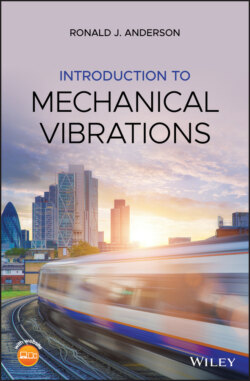Introduction to Mechanical Vibrations

Реклама. ООО «ЛитРес», ИНН: 7719571260.
Оглавление
Ronald J. Anderson. Introduction to Mechanical Vibrations
Table of Contents
List of Tables
List of Illustrations
Guide
Pages
Introduction to Mechanical Vibrations
Preface
About the Companion Website
1 The Transition from Dynamics to Vibrations
1.1 Bead on a Wire: The Nonlinear Equations of Motion
1.1.1 Formal Vector Approach using Newton's Laws
1.1.2 Informal Vector Approach using Newton's Laws
1.1.3 Lagrange's Equations of Motion
1.1.3.1 The Bead on a Wire via Lagrange's Equations
1.1.3.2 Generalized Coordinates
1.1.3.3 Generalized Forces
1.1.3.4 Dampers – Rayleigh's Dissipation Function
1.2 Equilibrium Solutions
1.2.1 Equilibrium of a Simple Pendulum
1.2.2 Equilibrium of the Bead on the Wire
1.3 Linearization
1.3.1 Geometric Nonlinearities
1.3.1.1 Linear EOM for a Simple Pendulum
1.3.1.2 Linear EOM for the Bead on the Wire
1.3.2 Nonlinear Structural Elements
1.4 Summary
Exercises
Notes
2 Single Degree of Freedom Systems – Modeling
2.1 Modeling Single Degree of Freedom Systems
2.1.1 Deriving the Equation of Motion
2.1.2 Equations of Motion Ignoring Preloads
2.1.3 Finding Spring Deflections due to Body Rotations
Exercises
Notes
3 Single Degree of Freedom Systems – Free Vibrations
3.1 Undamped Free Vibrations
3.2 Response to Initial Conditions
3.3 Damped Free Vibrations
3.3.1 Standard Form for Second‐Order Systems
3.3.2 Undamped
3.3.3 Underdamped
3.3.4 Critically Damped
3.3.5 Overdamped
3.4 Root Locus
Exercises
Notes
4 SDOF Systems – Forced Vibrations – Response to Initial Conditions
4.1 Time Response to a Harmonically Applied Force in Undamped Systems
4.1.1 Beating
4.1.2 Resonance
Exercises
5 SDOF Systems – Steady State Forced Vibrations
5.1 Undamped Steady State Response to a Harmonically Applied Force
5.2 Damped Steady State Response to a Harmonically Applied Force
5.3 Response to Harmonic Base Motion
5.4 Response to a Rotating Unbalance
5.5 Accelerometers
Exercises
Notes
6 Damping
6.1 Linear Viscous Damping
6.2 Coulomb or Dry Friction Damping
6.3 Logarithmic Decrement
Exercises
Notes
7 Systems with More than One Degree of Freedom
7.1 2DOF Undamped Free Vibrations – Modeling
7.2 2DOF Undamped Free Vibrations – Natural Frequencies
7.3 2DOF Undamped Free Vibrations – Mode Shapes
7.3.1 An Example
7.4 Mode Shape Descriptions
7.5 Response to Initial Conditions
7.6 2DOF Undamped Forced Vibrations
7.7 Vibration Absorbers
7.8 The Method of Normal Modes
7.9 The Cart and Pendulum Example
7.9.1 Modeling the System – Two Ways
7.9.1.1 Kinematics
7.9.1.2 Newton's Laws
7.9.1.3 Lagrange's Equation
7.10 Normal Modes Example
Exercises
Notes
8 Continuous Systems
8.1 The Equations of Motion for a Taut String
8.2 Natural Frequencies and Mode Shapes for a Taut String
8.3 Vibrations of Uniform Beams
Exercises
Notes
9 Finite Elements
9.1 Shape Functions
9.2 The Stiffness Matrix for an Elastic Rod
9.3 The Mass Matrix for an Elastic Rod
9.4 Using Multiple Elements
9.5 The Two‐noded Beam Element
9.5.1 The Two‐noded Beam Element – Stiffness Matrix
9.5.2 The Two‐noded Beam Element – Mass Matrix
9.6 Two‐noded Beam Element Vibrations Example
Exercises
Notes
10 The Inerter
10.1 Modeling the Inerter
10.2 The Inerter in the Equations of Motion
10.3 An Examination of the Effect of an Inerter on System Response
10.3.1 The Baseline Case –
10.3.2 The Case Where the Inerter Adds Mass Equal to the Block's Mass –
10.3.3 The Case Where is Very Large
10.4 The Inerter as a Vibration Absorber
Exercises
Notes
11 Analysis of Experimental Data
11.1 Typical Test Data
11.2 Transforming to the Frequency Domain – The CFT
11.3 Transforming to the Frequency Domain – The DFT
11.4 Transforming to the Frequency Domain – A Faster DFT
11.5 Transforming to the Frequency Domain – The FFT
11.6 Transforming to the Frequency Domain – An Example
11.7 Sampling and Aliasing
11.8 Leakage and Windowing
11.9 Decimating Data
11.10 Averaging FFTs
Exercises
Notes
12 Topics in Vibrations
12.1 What About the Mass of the Spring?
12.2 Flow‐induced Vibrations
12.3 Self‐Excited Oscillations of Railway Wheelsets
12.4 What is a Rigid Body Mode?
12.5 Why Static Deflection is Very Useful
Exercises
Notes
Appendix A Least Squares Curve Fitting
Appendix B Moments of Inertia
B.1 Parallel Axis Theorem for Moments of Inertia
B.2 Moments of Inertia for Commonly Encountered Bodies
Notes
Index
WILEY END USER LICENSE AGREEMENT
Отрывок из книги
Ronald J. Anderson
Queen’s University
.....
(1.36)
The components of can be substituted into Equation 1.26 to get the following expression for the generalized force arising from the damper
.....